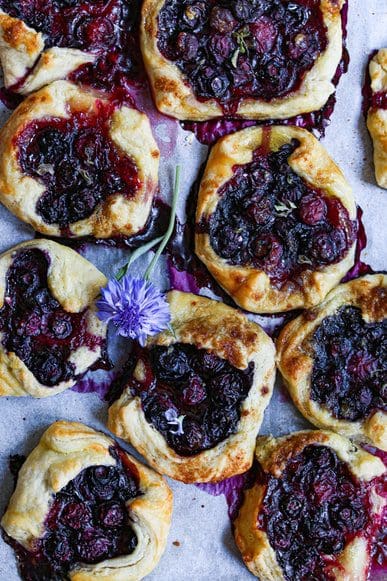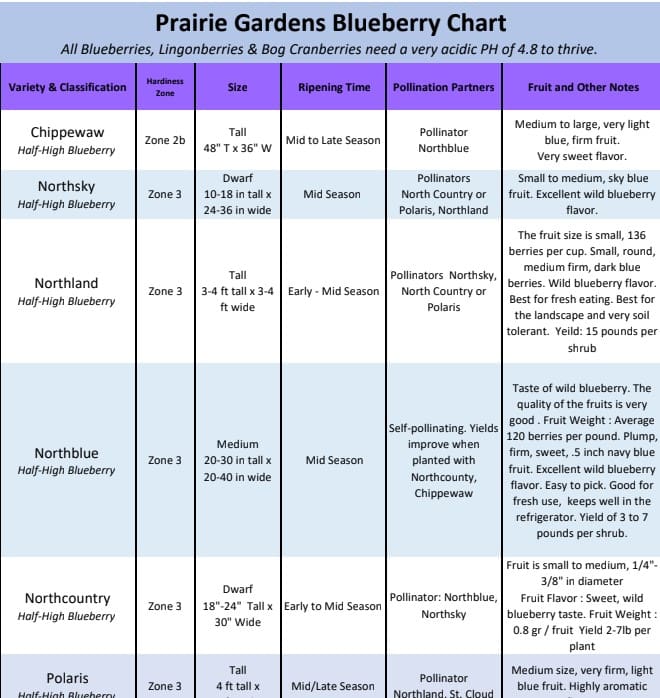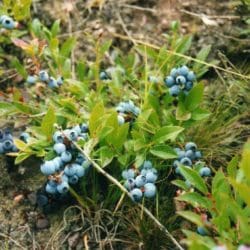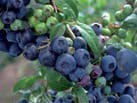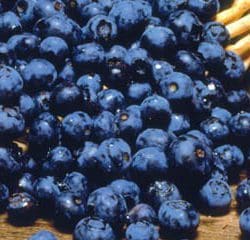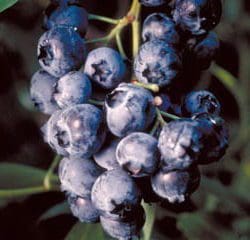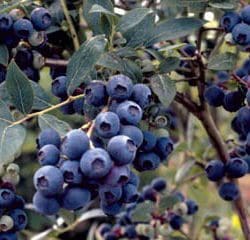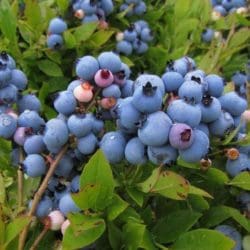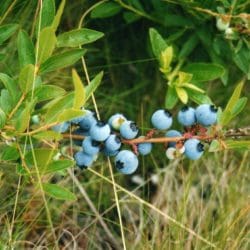For Edmonton Gardens (Zone 3-4)
Welcome to the art of growing Blueberries in Alberta – for Zone 3 gardens! You are going to be surprised by how many half-high blueberries are tough enough to grow in our -35C winter wonderland here in Alberta!
Most of the blueberry (Vaccinum) family hail from North America, where First Nations peoples have been enjoying them for centuries. In our region (zone 2) wild low-bush blueberries grow in abundance under the pine tree forest canopy, in the sandy soils just north of our farm. We often go on a blueberry picking expedition in early August, when the berries are at their peak! Of course – the pine trees have been growing wild in this region for eons, their needles acidifying the soil all around them. Just what blueberries love! Acidic soil – with a PH of about 4.5.

The Basics
Delectable fruit aside, blueberry bushes turn a glorious red in the fall. With the right soil (see below), blueberries are easy and well worth the blue fingers. They attract very few bugs, are easy to prune, and don’t shred you with thorns. They prefer full sun or partial dappled shade.
They are considered self-pollinating, but the half-high varieties do need another variety and having more than one plant will go a long way to increase your yield. As tempting as it is, pinch off all flowers the first year so it can’t bear fruit. It needs to develop its root system first. The bees love them, and will pollinate with great enthusiasm!
Blueberries need very acidic soil. And they are bog plants. They don’t like running short on water, but don’t want to be submerged. They thrive in the higher areas of the bog. They also need well-drained (sandy) soil, but like staying consistently moist. Tough crowd to please. Can’t dry out. Can’t sit in water. Can’t live under the pine or spruce trees (too dry). And they want good snow cover. But still worth the effort – the fruit is so good!
In the pine hills around us, they grow in low lying areas and around and lakes where the water table is close to the surface. However, if you are in drier land, an irrigation system, and few inches of wood mulch under their drip line will keep their shallow roots from parching. Because their roots are so shallow, avoid digging next to them.
Prairie Gardens Blueberry Chart
Did you know…
All Blueberries, Lingonberries & Bog Cranberries need a very acidic PH of 4.8 to thrive.
Download our chart of blueberry variety classifications, hardiness zones, ripening time, size, pollination partners and other important notes.
Pruning
Don’t prune them for the first 2 years while they establish. Patience is a virtue with blueberries; they’ll often live 100 years! After 2 years, trim off 1-3 of the oldest shoots per year. Your yield will take a while to go from “a nibble” to “just enough to graze on” to “pies for everybody!” It will start to yield at year 2 but will take a few more to reach its bountiful maturity, at which point you’ll have blue lips every time you visit the garden.
High vs. Low Bush vs Half-High Bush
The three main groups of blueberries are commonly grown, called Highbush, Half-High Bush and Lowbush.
Highbush Blueberries – Vaccinium corymbosum, are the 6’ giants grown on massive farms around the lower mainland area of BC, New Brunswick and Quebec. These varieties aren’t hardy on the Prairies. Zone 5-7.
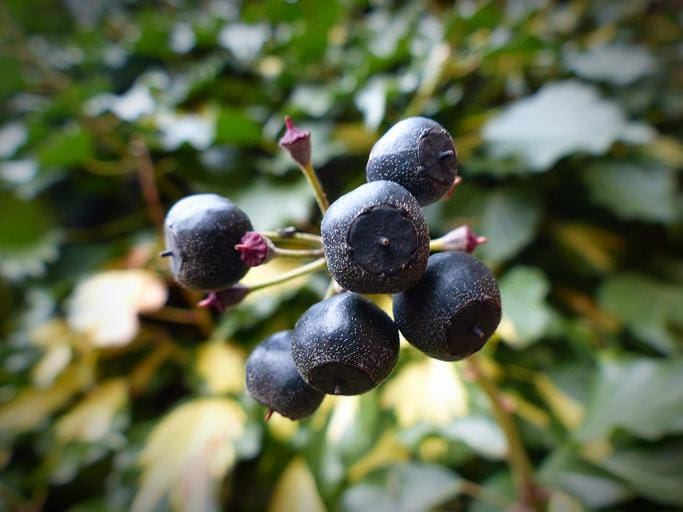
Lowbush – Vaccinium angustifolium.
They are small shrubs, rarely over 18” in height. Found on the eastern provinces, west to Saskatchewan and Minnesota, south to New York and Pennsylvania. The colorful cultivar, ‘Burgundy’, is a popular landscape plant. Zone 2.
Native Lowbush – Vaccimium myrtilloides
They’re also small 0 about 18” in height, and common across the Prairies in areas where pine trees thrive, completely hardy to zone 1, and produce clusters of tiny, sweet fruit. But the fruit is tiny – about ¼ size of commercial blueberries, so a lot of work to pick. We buy blueberry pickers from Lee Valley Tools, sort of a unique hand rake which scoops them off the plants by the cluster. Much faster picking, but still tedious work. Zone 1
Recently, hybridizers have developed “Half-High” varieties, which are a cross of low bush x high bush ! They grow to about 3’, are Alberta hardy and produce larger fruit than their low-bush cousins. Most of the popular varieties sold on the Prairies are half-highs, with people often being surprised at the blue bounty they can grow in our northern climate.
Acid Lovers
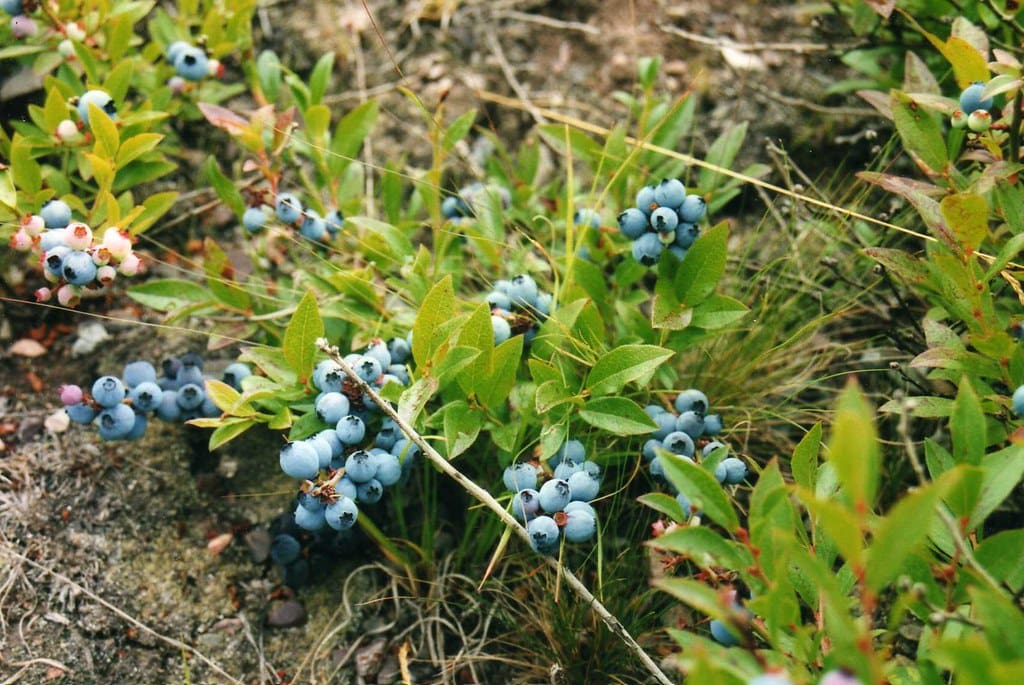
Do you know your garden soil PH? It is usually around 7 in our region. Blueberrys’ need for acidic soil is the most common stumbling block for everyone wanting to turn their green thumbs blue. Aim for a pH of 4.5 to 5. It’s well below normal soil but fairly easy to amend. Start by blending a generous amount of peat moss in with your soil; aim for a 1:1 ratio in your planting area. With a pH of 4.5, peat is the easiest way to both lower your pH and provide the ample drainage blueberries need. I don’t recommend planting in straight peat unless you’re committing to watering that spot more than the rest of your garden. Alternatively, add sulfur. Rototill in about 1 lb of sulfur per square yard the year before. You can also use wettable sulfur powder. 1 cup per plant spread out over a 2 foot diameter circle. Ideal is a pH of 4.5. Reapply sulfur when it rises to 5. Check after 3 months of above freezing weather. If it gets below 4, you used too much. But soil has an amazing buffering capacity, and our water PH is usually around PH 7 or higher (in Edmonton). It will creep back up again!
Once your peat is blended, grab 2 soil test kits from any garden centre or hardware store (for before and after). Depending on how neutral/ alkaline your sample is, you’ll want to add sulphur, coffee grounds (very acidic), pine or spruce needles to for an extra acidic nudge.
Blueberry Varieties for the Prairies (Zone 1-4 gardens)
View All Blueberry Options in our Shop
Native Blueberry: Vaccinium myrtilloides
Lowbush types are small shrubs, rarely over 18” in height. They’re native to the Prairies, grow wild amongst the pine trees in northern Alberta, are hardy as a rock and produce clusters of tiny, ¼ size of half-high sweet fruit. Common names included common blueberry, velvetleaf huckleberry, velvetleaf blueberry, Canadian blueberry.
View Native Blueberry in our shop >
Chippewa:
Vaccinium is the hardies cultivar that has marble sized medium-large berries; sky-blue color; sweet flavor; firm fruit; ripens with ‘Northblue.’ Yield and berry size benefit from cross pollination. The bush gets farirly big – 1 to 1.3 meters tall (3-4 feet) Large, sweet dark blue berries. Midseason. Northblue good pollinating partner.
Northsky: Small firm sky blue berries
Sweet, mild, aromatic fresh flavor; superior processed flavour. Low compact form. Very hardy. It features a dense canopy allowing the berries to tolerate heavy snow loads. Incidentally, the winter snow also serves to help protect the buds during severe cold. A Northsky Blueberry requires at least 800+ chilling hours. Ripens midseason around mid to the end of July. Needs pollinator pairing – with Northcountry or Polaris being good partners.
View Northsky Blueberry in our shop >
Northland: Large mid blue fruit with high sugar content
Bigger shrub, getting 1.2 to 2 meters tall (4 to 7 feet) Early to mid season. It has excellent winter hardiness and produces medium- to large-sized sweet berries 1-2 years after being planted, meaning you won’t have to wait 3-4 years as with other blueberry varieties. Chill Hours – The Northland Blueberry needs 800-1000 chill hours. Their ripening season is early- to mid-season and fruit is ready for harvesting in early Summer. Northland blueberries are known for their sweet taste. They’re preferred for jams, jellies, and sauces. You don’t have to use extra sweeteners with these blueberries. Blueberry size – A Northland blueberry is a medium or large size berry. You can fit 40-60 in a standard sized cup.
Northcountry: has slightly smaller dark blue berries that have a stronger flavour.
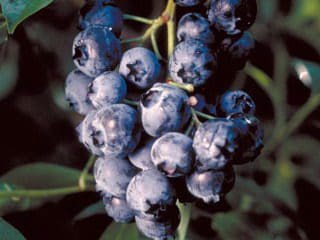
Smaller shrub 50-80 cm in height (18-30 inches). Early to mid season. Northcountry blueberry is well-suited to wintry climates, it requires 800-1000 chill hours (hours during which the temperature is below 45F) to realize the seasons have changed and it’s time to produce again in spring. These blueberries tend to ripen later in the year than many others. You can expect to harvest your Northcountry blueberries in late June to early July. The Northcountry Blueberry tastes just like a wild blueberry. The texture of the fruit is tender and fine.Fruit size is small to medium-sized fruit that is a standard dark blue color.This is a cold-tolerant blueberry variety that flourishes in zones 3-7. Pollination: The Northcountry Blueberry is self-pollinating, but it will yield larger crops if pollinated with the Northblue blueberry.
View Northcountry Blueberry in our shop >
Northblue: has large dark blue, firm berries; good fresh flavor; superior processed flavor.
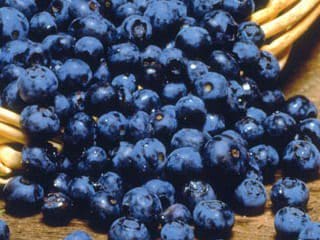
Smaller shrub – (24 inches wide x 36 inches tall) (30 cm x 1m). It tends to be a little leggy, with a typical clearance of 1 foot from the ground. It grows at a fast rate, and under ideal conditions can be expected to live for approximately 20 years. This variety requires a different selection of the same species growing nearby in order to set fruit.
View Northblue Blueberry in our shop >
Polaris:
Half-high cultivars are typically known for their cold hardiness which can reach down to -35°F or even -45°F and their moderate size, making this plant ideal for both home and commercial cultivation. The Polaris blueberry is known for its cold tolerance. In fact, this variety was said to be introduced by the University of Minnesota, an indication of its tolerance to Midwest winters. Chilling Level – Able to tolerate all but the most extreme Midwest weather, Polaris plants can thrive with winter chills between -40° to -30°F. Ripens Midseason. Fruit Qualities – Medium-large berries; very firm and very very crisp texture; intense aromatic flavor; excellent storage capability; ripens 7 days earlier than ‘Northblue.’ Requires second cultivar for pollination. Northcountry is a good pollinator match.
View Polaris Blueberry in our shop >
St. Cloud:
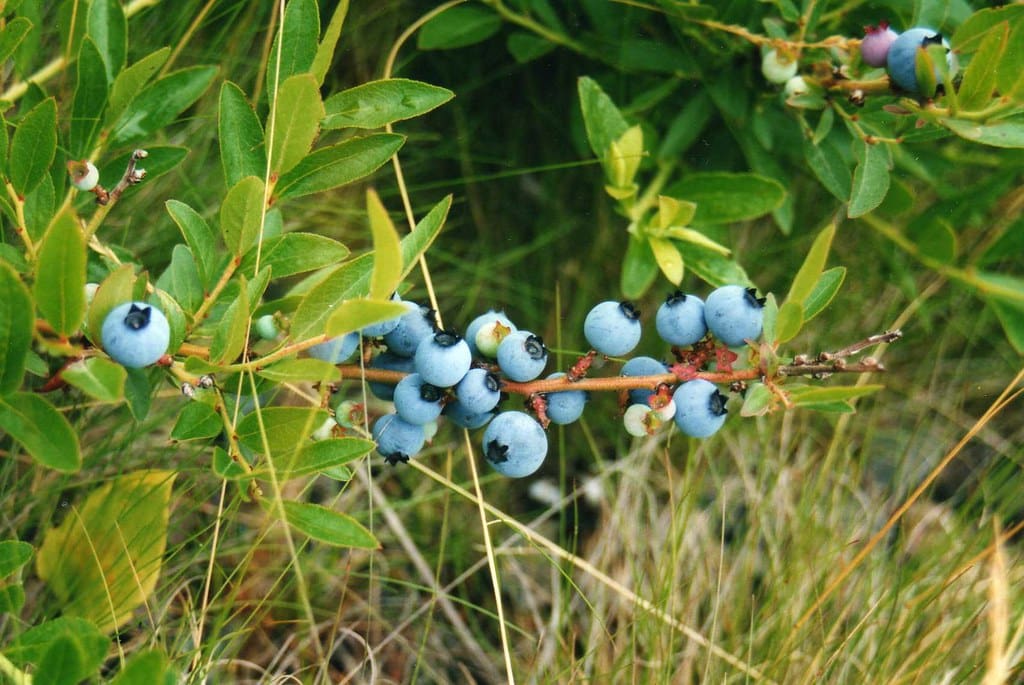
This blueberry reaches about 4′ tall at maturity, and produces a good quantity of sweet blueberries (between 5-7 pounds) in the early summer. Berry size is medium, and they come ripe with the wild blueberry crop when grown in northern latitudes. Selected by the University of Minnesota, St. Cloud can handle cold winters and snowy weather. It is a good size for covering to protect the crop from birds as well. I am always impressed by it’s perpetual yield of sweet berries despite the weather variety that plague northern gardeners St. Cloud does require a pollinator for good fruit set. Good companions are: Northblue, North Sky, Friendship, Polaris, Chippewa, any of the wild lowbush blueberries; and any hardy northern highbush cultivars. Zone 4.
View St. Cloud Blueberry in our shop >
Blueberries Available In Our Shop
Chippewa Blueberry
Price range: $19.95 through $34.95 Select options This product has multiple variants. The options may be chosen on the product pageCombination Blueberry
Price range: $39.95 through $75.00 Select options This product has multiple variants. The options may be chosen on the product pageNative Blueberry
$19.95 Read moreNorthblue Blueberry
Price range: $19.95 through $34.95 Select options This product has multiple variants. The options may be chosen on the product pageNorthcountry Blueberry
Price range: $19.95 through $34.95 Select options This product has multiple variants. The options may be chosen on the product pageNorthland Blueberry
Price range: $19.95 through $34.95 Select options This product has multiple variants. The options may be chosen on the product pageNorthsky Blueberry
Price range: $19.95 through $34.95 Select options This product has multiple variants. The options may be chosen on the product pagePolaris Blueberry
Price range: $19.95 through $34.95 Select options This product has multiple variants. The options may be chosen on the product pageSt. Cloud Blueberry
Price range: $19.95 through $34.95 Select options This product has multiple variants. The options may be chosen on the product page

